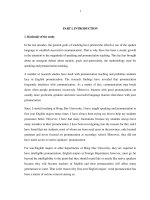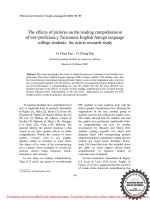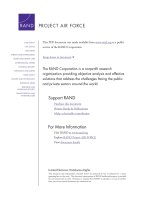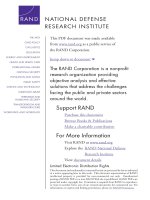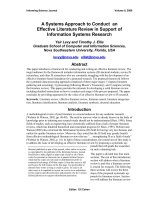Using a content-based approach to teaching environmental English to students An action research = Sử dụng phương pháp dựa vào nội dung để dạy tiếng anh chuyên
Bạn đang xem bản rút gọn của tài liệu. Xem và tải ngay bản đầy đủ của tài liệu tại đây (760.03 KB, 74 trang )
VIETNAM NATIONAL UNIVERSITY, HANOI
UNIVERSITY OF LANGUAGES AND INTERNATIONAL STUDIES
FACULTY OF POST-GRADUATE STUDIES
*********************
MAI THỊ THANH
USING A CONTENT-BASED APPROACH TO TEACHING
ENVIRONMENTAL ENGLISH TO STUDENTS: AN
ACTION RESEARCH
Sử dụng phương pháp dựa vào nội dung để dạy tiếng anh chuyên ngành
môi trường cho sinh viên: Phương pháp cải tiến sư phạm
M.A MINOR PROGRAMME THESIS
FIELD: ENGLISH TEACHING METHODOLOGY
CODE: 60140111
Hanoi, 2014
VIETNAM NATIONAL UNIVERSITY, HANOI
UNIVERSITY OF LANGUAGES AND INTERNATIONAL STUDIES
FACULTY OF POST-GRADUATE STUDIES
*********************
MAI THỊ THANH
USING A CONTENT-BASED APPROACH TO TEACHING
ENVIRONMENTAL ENGLISH TO STUDENTS: AN
ACTION RESEARCH
Sử dụng phương pháp dựa vào nội dung để dạy tiếng anh chuyên ngành
môi trường cho sinh viên: Phương pháp cải tiến sư phạm
M.A MINOR PROGRAMME THESIS
FIELD: ENGLISH TEACHING METHODOLOGY
CODE: 60140111
SUPERVISOR: Dr. Trần Hoài Phương
Hanoi, 2014
i
DECLARATION
I declare that the thesis entitled “Using a content-based approach to
teaching English to students of environmental studies: an action research”
is the result of my own research for the Degree of Master of Arts at
University of Languages and International Studies, Vietnam National
University, and that this thesis has not been submitted for any degree at any
other university or tertiary institution.
Ha Noi, September 2014
Signature
Mai Thị Thanh
ii
ACKNOWLEDGEMENTS
First and foremost, I would like to express my profound gratitude to my
supervisor, Dr. Trần Hoài Phương, for her valuable instructions, constructive
criticisms and her kindly encouragement during the development of this
thesis. Without her guidance the thesis would have been impossible.
My special thanks go to all professors and lecturers at the Faculty of Post-
Graduate Studies, University of Languages and International Studies – VNU
for their useful lectures, helpful suggestions, and tireless assistance.
I am also grateful to my colleagues and the third-year students of
Environment at Central Regional College of Natural Resources and
Environment for their invaluable feedback, support and participation in this
research.
Finally, to my beloved family go my heart-felt thanks for their understanding
as well as their help throughout my graduate program.
iii
ABSTRACT
The study was conducted to investigate the effectiveness of using a
content-based approach to teaching English to students of environment major:
an action research at Central College of Natural Resources and Environment.
The specific objectives of the study were: (1) to examine the extent to which
the attitude of students toward English skills and ESP at Central College of
Natural Resources and Environment was changed following the application of
the content-based approach to teaching Environmental English in their class,
and (2) to investigate how effective the application of content-based
instruction (CBI) was in helping students at Central College of Natural
Resources and Environment learn Environmental English. The action research
procedure was carried out on 32 students of Environment major from one
class by the teacher in charge of the class, and one English teacher as an
observer The effectiveness of the course was investigated by means of
questionnaires completed by 32 students, their pre-test, post-test scores, and
teachers’ observation. It was found that this application of a content-based
approach had brought about positive results for the students at elementary
level of English. It is to enrich students’ specific terms as well as develop
their English skills related to environment major.
iv
LIST OF TABLES AND ABBREVIATION
1. TABLES
Table 1: English study background
Table 2: Students’ skills weakness
Table 3: Skills important for future job
Table 4: The usefulness of ESP
Table 5: Students’ ESP learning style
Table 6: Material input in the CBI approach
Table 7: t-Test: Paired Two Sample for Means
2. ABBREVIATIONS
EAP: English for Academic Purposes
EGP: English for General Purposes
EFL: English as a foreign language
ELT: English Language Teaching
EOP: English for Occupational Purposes
ESP: English for Specific Purposes
GE: General English
CRCNRE: Central Regional College of Natural Resources and Environment
NRE: Natural Resources and Environment
M.A: Master of Arts
ULIS: University of Languages and International Studies
VNU: Vietnam National University
ESL: English as a Second Language
TVET: technical and vocational education and training
IT: Information Technology
CBI: content-based instruction
v
TABLE OF CONTENTS
DECLARATION i
ACKNOWLEDGEMENTS ii
ABSTRACT iii
LIST OF TABLES AND ABBREVIATION iv
PART I: INTRODUCTION 1
1. Rationale for choosing the topic 1
2. Purposes of the study: 2
3. Research questions 3
4. Significance of the study 3
5. Design of the study 3
PART II: DEVELOPMENT 5
CHAPTER 1: LITERATURE REVIEW 5
1.1. Definitions of ESP and related concepts 5
1.1.1. ESP/EAP/EOP 5
1.1.2. English for non-majors, English for majors and ESP in Vietnam 7
1.1.3. English for non-majors and ESP in practice in Vietnam 9
1.2. A content- based approach 12
1.2.1. Definitions of content-based instruction 12
1.2.2. Types of Content-Based Instruction 14
1.2.3. Theme-based model in designing ESP material 15
1.3. Issues of CBI 16
1.4. An example of CBI 18
1.5. Chapter summary 20
CHAPTER 2: THE STUDY 21
2.1. The participants and CRCNRE context 21
2.2. Methodology 24
vi
2.2. Action research procedure 27
CHAPTER 3: RESULTS AND DISCUSSIONS 30
3.1. The results of the pre-treatment questionnaire survey 30
3.1.1. Students’ English study background 30
3.1.2. Students’ perceptions of their weakness 31
3.1.3. Skills important for future job 31
3.2.1. Data collected from the post test 32
3.2.2 Data collected from the post-questionnaire (second part) 34
PART III: CONCLUSION 37
1. Conclusions 37
2. Limitations of the study and suggestions for further study 37
REFERENCES 39
APPENDIX 1: PRE-TREATMENT QUESTIONAIRE I
APPENDIX 2: POST-TREATMENT QUESTIONAIRE III
APPENDIX 3: PRE-TEST V
APPENDIX 4: POST-TEST X
APPENDIX 5: SAMPLE OF LESSON PLAN APPLYING CONTENT-
BASED APPROACH…… XV
APPENDIX 6: CLASSROOM OBSERVATION SHEET XXV
1
PART I: INTRODUCTION
1. Rationale for choosing the topic
The unprecedented spread of English throughout the world in recent
years has resulted in its major role and high prestige in the academic, cultural,
and political landscape of a growing number of countries (Crystal, 1995,
1997; Fishman, Cooper, and Conrad, 1977; McArthur, 1998, 2002). Because
of its international role in international economic relations and cultural
exchange, the need for communication in English is becoming more and more
important. As Harmer (1991) indicates ―people want to study English because
it offers a chance for advancement in their professional lives‖.
―Traditionally the aim of linguistics had been to describe the rules of
English usage, that is, the grammar. However the new studies shifted attention
away from defining the formal features of language usage to discovering the
ways in which language is actually used in real communication‖ (
Widdowson, 1978, in Hutchinson & Waters, 1987, p. 7). With subsequent
developments, it required an emergence for English courses tailored to
specific needs for groups of learners that people called English for Specific
Purposes or ESP for short. Since its emergence in the late 1960s, ESP has
drawn upon three major realms of knowledge: language, pedagogy and the
students/ participants’ specialist areas (Hutchinson & Waters, 1987, p. 9).
However, after some initial success, ESP was found to be of some limitations
to both teachers and learners. For example, Hutchinson and Waters (1987)
indicate that as well as having to cope with the uncertain values of the strange
land of ESP, ESP teachers may also have to struggle to master language and
subject matter beyond the bounds of their previous experience. Also, as ESP
is language-centred, and the language-driven approach is in its dominance,
this mode unintentionally poses many difficulties on teachers and learners as
2
they have to cope with linguistics surface form through monotonous specialist
texts. Rivers (1992) points out that although learners can participate in
memorized conversations easily and effortlessly, hardly any can produce at
length fluent variations from the basic materials, and none could talk on
unrehearsed topics without hesitation. In the trend of integration nowadays, a
country can hardly be isolated and self-sufficient.
As for the local context, since Vietnam became the 150
th
member of the
World Trade Organization in 2007, more and more foreign investors have
poured capital into Vietnam. English has become the ultimate means of
communication in foreign trade. To meet the society’s needs, Vietnamese
students must have sound English knowledge to work well in their jobs. They
need to be not only proficient in general English (GE) but also capable of
interpreting specialist contents. To help students achieve this aim, the choice
of appropriate learning materials in harmony with suitable teaching methods
is considered as a vital and primary concern for ESP teachers, language
program developers, and also curriculum designers. It was mainly this reason
that motivated the researcher to choose the thesis topic: ―Using a content-
based approach to teaching English to students of environmental studies: An
action research study‖
2. Purposes of the study:
This study aims at exploring the effectiveness of the application of a
content-based approach in teaching Environmental English studies at Central
College of Natural Resources and Environment.
The specific objectives of the study are:
- To examine the extent to which the attitude of students at Central College
of Natural Resources and Environment was changed following the application
of a content-based approach in teaching Environmental English in their class.
3
- To investigate how effective the application of a content-based approach
was in helping students at Central College of Natural Resources and
Environment learn Environmental English.
3. Research questions
In order for sufficient and necessary data and information to be collected,
the following three major questions were answered, namely:
Question 1: To what extent does the application of a content-based approach
change the attitude of students at Central College of Natural Resources and
Environment toward learning environmental English?
Question 2: To what extent does the application of a content-based approach
help students at Central College of Natural Resources and Environment to
learn environmental English?
4. Significance of the study
This study is hoped to make both theoretical and practical contributions
to the field of ESP in Vietnam. Specifically, the intended theoretical
significance of the study is that the study supplies the English language
teachers with an understanding of a content-based approach to teaching
Environmental English studies along with its advantages and disadvantages
when employed in the context of a Vietnamese college. In addition, the study
also suggests some ways to use a content-based approach successfully during
all stages of teaching ESP.
5. Design of the study
This study is divided into three main parts. Part A, INTRODUCTION,
presents the rationale for choosing the topic, the aims and objectives, the
scope, the significance and the design of the study. Part B, DEVELOPMENT,
has three following chapters:
Chapter one presents the literature review which deals with the
4
theoretical background that precedes and necessitates the formation of our
research. Chapter Two details the methodology applied in the study including,
a brief introduction to the action research design, the setting, participants,
instrumentation, and the action research procedure. Chapter Three presents
results and discussions, and implications of the results for the teaching of
Environmental English studies. Part C, CONCLUSION, summarizes the
findings and proposes possible solutions to the problems identified.
Limitations of the study and suggestions for further study are also discussed
in this part.
5
PART II: DEVELOPMENT
CHAPTER 1: LITERATURE REVIEW
1.1. Definitions of ESP and related concepts
1.1.1. ESP/EAP/EOP
To date, there have been a variety of views and definitions of English for
Specific Purposes (ESP) in contrast with General English (GE), such as those
suggested by Munby (1978), Kennedy and Bolitho (1984), Robinson (1991),
Dudley-Evans (1998), etc. Most of the authors agree that ESP courses are
those entirely governed by the communicative needs of the learner with
regards to the curriculum and teaching/learning materials (Munby, 1978), or
those based on the learner’s purposes identified through investigations and
their communicative needs generated from those purposes (Kennedy and
Bolitho, 1984). Meanwhile, Robinson (1991) believes that ESP aims at the
final goals and is based on needs analysis, which informs the course designers
of what the learner expects and is expected to be able to perform through the
means of English. Despite individual differences in their wording, these
conceptualizations center round a common core: the specific needs of the
learner.
Carrying these views further, Dudley-Evans (1998) identifies ESP as
containing such characteristics as the following:
i. An ESP course is designed to satisfy specific needs of the learner;
ii. It applies the methods and [linguistic] activities of the discipline or field it
serves;
iii. It focuses on the type of language relevant to those activities in terms
of grammar, vocabulary, style, register, discourse and rhetoric’s, to name just
a few.
6
In most cases, ESP is dedicated to adult learners at tertiary, vocational
education and training service providers, or working at particular institutions.
These learners tend to start from the intermediate or advanced level, i.e. they
have already had a fundamental command of English. In other words, they
have reached a considerable level of GE before commencing their ESP
course. This also means that ESP may not be suitable for complete beginners,
and helps distinguish GE from ESP.
According to Hutchinson and Waters (1987:17), ESP can comprise
several branches, as the tree on the following page clearly displays. As seen
in the ELT tree, 3 representatives of ESP include English for Science and
Technology, English for Business and Economics, and English for Social
Sciences. These are further divided into more specific ones such as EAP
(English for Academic Purposes) and EOP (English for Occupational
Purposes), which cover English for Medicine, English for Technicians,
English for Office Staff, English for Psychology, amongst others. Naturally,
this is a non-exhaustive list, since each of these ―Englishes‖ can still be
further specified, e.g. English for Medicine can be broken down into English
for Surgeons vs. English for Operating Theater Assistants, English for
General Nurses vs. English for Dentistry, etc.
7
The Tree of ELT (Hutchinson and Waters, 1987:17)
1.1.2. English for non-majors, English for majors and ESP in Vietnam
In Vietnam, the term ―tiếng Anh không chuyên‖ (lit. English for Non-
majors or Non-language Majors) is used in contrast to ―tiếng Anh chuyên
ngữ‖ (lit. English for [Language] Majors), which has caused certain
confusion, especially when the term ESP was introduced.
8
First, English for Non-majors refers to the English program delivered to
students of different disciplines who will use English as an additional
instrument for their studies and work, while English for Majors means the
English program for those who are going to work as English teachers or
interpreters, to name just two of the possible occupations graduates from this
program can assume. In other words, different uses of English will serve as
the livelihood to majors while English is only secondary to non-majors.
English for Majors can be offered to:
i. High school students who demonstrate a high level of language
aptitude. This program is available only at a selected number of institutions,
e.g. the Special High School belonging to the University of Languages and
International Studies (ULIS) under VNU, the Special High School belonging
to Hanoi University of Education in the city of Hanoi, and some classes in
Lam Sơn High School in Thanh Hoá province and similar high schools in
other provinces;
ii. Undergraduate students at various higher educational institutions along the
country.
Typical features of this program’s curricula include ―traditional
philological models centering round English linguistic theory, English
language practice and English literature‖ (Cao Thanh Hương, 2004:28). As
has been described, graduates from this program can work as interpreters,
translators, language teachers, linguistic or literary researchers, etc.
Therefore, compared to different terms in the ELT tree above, English for
Non-majors in Vietnam is far more inclusive, covering both GE and ESP,
while English for Majors is close to ESL (English as a Second Language) or
EFL (English as a Foreign Language), although there is little natural linguistic
environment for students to practice the language outside their classrooms.
9
Furthermore, the term English for Non-majors so far seems to have been
connotatively interpreted as fairly low levels of English, i.e. those non-majors
are poor English users in the eyes of the supposedly more ―linguistically able‖
majors.
The two terms majors and non-majors had been prevalent in the country
until the mid-1990s when another concept made its appearance – ESP.
Several Vietnamese foreign language educators believe ESP is the one with
limited use in particular specializations or disciplines (Cao Thanh Hương,
2004:29). This again coincides with what has been suggested by several
authors cited above.
1.1.3. English for non-majors and ESP in practice in Vietnam
However, interpretations of the concepts English for Non-majors and
ESP vary across different administrators and program designers who are
influential to course design, which results in differences in foreign language
training curricula and methodology. Prior to the 1990s, only a few could
develop appropriate courses for their students, e.g. Hanoi University of
Technology, Hanoi University of Civil Engineering, or Hanoi University of
National Economics where relevant reading materials were compiled. In the
former Hanoi University (now Vietnam National University, Hanoi, or VNU
for short), a number of textbooks were developed in accordance with ESP
principles, for instance English for Economics by Lê Thụy Ánh, which
partially responded to essential needs of the students majoring in these
disciplines. In other institutions, however, due to the diversity of programs
offered, and the uncertainty of what particular jobs graduates are likely to
take, true ESP courses were hard to design and deliver. Most of what was
called ESP was actually hours of laborious struggle with subject-matter
10
reading materials full of unfamiliar concepts and huge numbers of highly
professional terms to teachers and students alike.
As a result, the prevalent method then was grammar-translation, which
produced graduates who could read and translate materials of the subject they
majored in, yet their listening and speaking skills were fairly poor. This is
possibly the reason why non-majors tend to be described as ―deaf and dumb‖
when it comes to communication in English. Teachers of English to non-
majors consequently had to suffer as well: they may be regarded as second-
class compared to teachers of English to majors, and both could not be on the
par with subject-matter lecturers. Never had foreign language teaching,
including English teaching, been regarded as a science proper.
Since the early 1990s, progress has been made in the perception towards
foreign language teaching in the country, which has brought about positive
changes to both the curricula and teaching methodology. A brief look at some
English curricula accessible to us below can help illustrate this point.
The English program for technical and vocational schools developed by Lê
Ngọc Tường et al (2002: 6) clearly points out, ―the program … is topic-based,
i.e. topics serve as the basis for selecting reading materials, exercises and
activities in each unit; they govern the linguistic content of the program.‖ The
program thus aims at the target careers and/or professions of the learners.
Nevertheless, given the variety of technical and vocational schools in the
country, the topics identified in the program remain generic and suggestive in
their nature, which requires each technical and voctioanal education and
training (TVET) provider to continue to specify them further for their own
students.
The ESP Reading Syllabus for 2nd-year Students of Plants and
Vegetation at Tây Nguyên University by Ngô Văn Thông (2004) is also topic-
11
based, with reading sub-skills and grammar sections similar to any GE course.
The most typical ESP elements lie in the vocabulary introduced, for instance,
Unit 1 on traditional rice cultivation, Unit 4 on water resources and irrigation
works, Unit 5 on agricultural machinery and technical equipment. However,
strategies for vocabulary building and professional terminology development
as well as the linguistic rhetoric and register of the field remain unclear.
In the same vein, the ESP Reading Syllabus for 2
nd
-year Students of
Informatics-Electronics at Dak Lak Technical College by Trần Thị Cẩm Linh
(2004) suggested topics like Unit 1 - What is a computer?, Unit 2 – How do
computer systems process data?, Unit 5 – Disks and Disk Drives, which
demonstrate the author’s efforts to associate language skills with their
communicative functions, e.g. descriptions of components and characteristics,
giving instructions, or explaining procedures. Again, like the ESP course on
Plants and Vegetation above, this syllabus does not make it clear how many
entries there should be in these IT students’ lexicon, or what makes IT
English register differ from English used in other areas of study. By and
large, these two syllabi are more EAP- than EOP-oriented.
Unlike the above, the ESP Listening-Speaking Syllabus for 3
rd
-year
Students of Hotel Management at Phuong Dong University by Trịnh Thị Nha
Trang (2004) tried to combine topics with communicative situations and
functions, with situations highly predominant. For example, Unit 2 – Hotel
Check-in contains listening and speaking activities in possible situations at
hotel front office, while Unit 4 – Food Service centers around various
situations which are likely to occur in restaurants. Topics in the course evolve
as a sequential journey from the time a guest books a hotel room, prepare to
depart, arrive at the hotel to the time he/she pays and leaves. EOP for hotel
management staff is the apparent orientation governing this course.
12
Scanning several other M.A. theses with the same purposes of ESP
syllabus design, either in listening, speaking or reading, particularly those on
reading, which are directly relevant to our study, e.g. Đặng Thị Lệ Quyên
(2014), Nguyễn Thị Thanh Hà (2011), etc., we can see a similar topic-based
trend in their design: they start with topics, then proceed to the particular
reading sub-skills to be practiced; next come the linguistic items (lexical
resources, technical terms, grammatical structures, etc.) related to the topics
and reading sub-skills, and finally other tasks like translation or some
integrated skills of speaking, writing or listening based on the reading.
Realizing the strengths and weaknesses of these courses, and taking into
account the particular needs of the students of Accounting at CRCNRE, we
hope to be able to create a more appropriate ESP syllabus on the basis of the
study.
1.2. A content- based approach
1.2.1. Definitions of content-based instruction
Content-Based Instruction (CBI) is ―an approach to second language
teaching in which teaching is organized around the content or information that
students will acquire, rather than around a linguistic or other type of syllabus‖
(Richards & Rodgers, 2001, p.204). In other words, CBI involves integrating
the learning of language with the learning of content simultaneously; here,
content typically means an academic subject matter such as math, science, or
social studies. In CBI, the language is utilized as the medium for teaching
subject content (Mohan, 1986). The language learning objectives are achieved
through content learning. The syllabi in most CBI courses are derived from
content areas, and vary widely in detail and format. In a word, CBI is a
method of teaching language and content in tandem.
13
CBI requires better language teachers. Language teachers must be
knowledgeable in content areas and be able to elicit knowledge from students.
In addition, language teachers have such responsibility as to keep context and
comprehensibility foremost in their instruction, to select and adapt authentic
materials for use in class, to provide scaffolding for students’ linguistic
content learning, and to create learner-centered classrooms (Stryker & Leaver,
1993).
CBI requires better learners as well. Students are hypothesized to become
autonomous and independent in CBI, so that they are conscious of their own
learning process and can take charge of their learning. Furthermore, students
are expected to support each other in collaborative modes of learning. Finally,
students need to make commitment to this new approach to language learning
(Stryker & Leaver, 1993). Typically, the materials in CBI are used with the
subject matter of the content course. It is recommended that ―authentic‖
materials are identified and utilized. There are two implications of
authenticity. One implication is that the materials are similar to those used in
native-language instruction; the other relates to the use of newspaper and
magazine articles and any other media materials ―that were not originally
produced for language teaching purposes‖ (Brinton et al., 1989). Some realia
such as tourist guidebooks, technical journals, railway timetables, newspaper
ads, or TV broadcasts are also recommended by many CBI practitioners
(Richards & Rodgers, 2001).
CBI in language teaching has been widely used in a variety of different
settings since 1980s such as English as Specific Purpose (ESP) Programs for
Students with limited English Proficiency (SLEP), Language for Specific
Purposes (LSP), immersion programs, and ESL/EFL Language Programs.
Since CBI refers to an approach rather than a method, no specific techniques
14
or activities are associated with it. At the level of procedure, teaching
materials and activities are selected according to the extent to which they
match the type of program. Finally, CBI provides the opportunity for teachers
to match students’ interests and needs with interesting, comprehensible, and
meaningful content (Brinton et al., 1989).
1.2.2. Types of Content-Based Instruction
1.2.2.1 Theme-based Model
Theme-based language course is structured around topics or themes.
Major principles underlying theme-based model contain automaticity,
meaningful learning, intrinsic motivation, and communicative competence
(Brown, 2001). Its primary purpose is to help students develop second
language competence within specific topic areas. The topics chosen can be
several unrelated topics or one major topic. Language instructors are
responsible for language and content instruction (Brinton et al., 1989). The
theme-based model is mainly employed in adult schools, language
institutions, and all other language programs. It is suitable for low to
advanced learners.
1.2.2.2. Sheltered Model
Sheltered instruction is an approach to using second language acquisition
strategies while teaching content area instruction. In the sheltered model, an
academic subject matter is taught by content teachers in content areas, such as
science, mathematics, history, or literature via using language and context to
make the information comprehensible. Characteristics of sheltered instruction
include comprehensible inputs, warm and affective environments, high levels
of student interaction, student-centered, hands-on tasks, and comprehensive
planning (Echevarria & Graves, 2003). In the sheltered model, content
courses are taught in the second language by a content area specialist to a
15
group of ESL learners having been grouped together (Richards & Rogers,
2005) or a language teacher with content-area knowledge (Gaffield Vile,
1996).
1.2.2.3. Adjunct Model
Adjunct model constitutes a more sophisticated pattern for the integration
of language and content. It aims at connecting a specially designed language
course with a regular academic course. In the adjunct model, students enroll
in two linked courses simultaneously—a content course and a language
course. The content instructor focuses on academic concepts while the
language instructor emphasizes language skills using the content-area subject
as a background for contextualizing the language learning process (Brinton et
al., 1989). The rationale of this model is that the linked courses can assist
students developing academic coping strategies and cognitive skills which can
be transferred to other disciplines. The adjunct model is suitable for high
intermediate to advanced levels (Brinton et al., 1989).
In summary, these three models of CBI share a number of common
features. First, authentic tasks and materials are used in the three models.
Second, they all share the principle that helps students deal with the content
materials. On the other hand, they also differ in several ways, including the
course aim and learning objectives, instructor’s roles, students’ proficiency
levels, and evaluation approaches.
1.2.3. Theme-based model in designing ESP material
Brinton et al. (1989) indicate that theme-based courses constitute the
most common model in CBI thanks to its relative lack of complexity for
implementation. In the theme-based model, selected topics or themes provide
the content for students to learn. Themes are the central ideas that organize
major curricular units, so they have to be chosen to be appropriate to students’
16
academic and cognitive interests and needs. Moreover, materials in theme-
based language instruction are usually teacher-generated or adapted from
outside sources.
For Eskey (1997), theme-based instruction adds a missing dimension to
traditional approaches to language syllabus design. Where both form-based
and notional/ functional syllabi focus on rules, rather than on real
communication, theme-based language courses give learners an interesting
subject to learn or communicate about. Language is used to explore content,
and language growth emerges as students need to comprehend or produce
language relating to content. Theme-based CBI is particularly appealing in
this respect because teachers can use almost any content materials that they
feel their students will enjoy. Brinton et al. (1989) indicate that authentic
materials with simplified language are of great choice with an attempt to
integrate the topic into the teaching of all language skills. Moreover, Grabe
and Stoller (1997) share that keeping students motivated and interested are
two important factors underlying content-based instruction. Motivation and
interest are crucial in supporting student success with challenging,
informative activities that support success and help the students learn complex
skills: reading, speaking, listening and writing.
1.3. Issues of CBI
Stryker and Leaver (1993) state that there may be a challenge for learners
to participate in CBI courses. CBI is in the ―learning by doing‖ school of
pedagogy. Learners are expected to be active in different roles and
cooperative with each other. In addition, they need a commitment to learn
language in CBI courses. This is an issue for students who are accustomed to
whole-class, independent, and traditional learning and teaching models.
Additionally, learners need to possess a minimum level of language
17
proficiency so that they can understand the quantity of new information in
CBI courses. Stryker and Leaver (1993) suggest that students need to be
prepared both psychologically and cognitively for CBI, and if they are not
adequately prepared, then teachers should offer the missing schemata needs
for students. Or students need to be kept from enrolling in CBI courses until
they are ready. In my opinion, I would suggest that teachers need to design a
lesson that is intriguing and appealing enough to encourage students to
participate in the lesson. Moreover, teachers must know how to shelter the
content to make it accessible to students.
Another issue is that language teachers have been trained to teach
linguistic knowledge rather than a content subject. Hence, language teachers
―may be insufficiently grounded to teach subject matters.‖ (Richards &
Rodgers, 2001, p.220). Indeed, language teachers have not been trained to
teach content subjects, and may be questioned about their credibility in CBI
courses. From my perspective, I would say that language teachers can ask for
assistance from content teachers. Additionally, language teachers can choose
a content subject that they are familiar with to instruct. Do not try to teach all
subject matters, that is, language teachers should start small. Finally, language
teachers can attend professional development workshops to let themselves
have second, third, or even fourth profession.
Another problem associated with CBI is that language teachers are too
concerned with content area teaching and neglect teaching related language
skills. Language teachers seem to forget the main purpose of CBI is to
enhance language development though content areas rather than content
learning per se. If language components are missing, it cannot be called CBI.
The language learning aspect should have equal priority with the content
learning facet in CBI (Cristopher, 1996).
